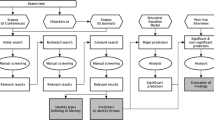Abstract
In this article we report on the JIAC V team for the agent programming competition 2009, going through the different phases of development and describing the JIAC V agent framework. Based on an iterative approach, we identified and implemented different agent roles. While there is no explicit team concept, the agents cooperate by informing each other of their perceptions and intentions, which leads to emergent team behavior which very dynamically and flexibly reacts to the state of the game.
Similar content being viewed by others
References
Hirsch, B., Konnerth, T., Heßler, A.: Merging agents and services—the JIAC agent platform. In: Bordini, R.H., Dastani, M., Dix, J., El Fallah Seghrouchni, A. (eds.) Multi-Agent Programming: Languages, Tools and Applications, pp. 159–185. Springer, New York (2009)
Patzlaff, M., Tuguldur, E.O.: MicroJIAC 2.0—the agent framework for Constrained devices and beyond. Technical Report TUB-DAI 07/09-01, DAI-Labor, Technische Universität Berlin (2009). http://www.dai-labor.de/fileadmin/files/publications/microjiac_20_2009_07_02.pdf
Fricke, S., Bsufka, K., Keiser, J., Schmidt, T., Sesseler, R., Albayrak, S.: A toolkit for the realization of agent-based telematic services and telecommunication applications. Commun. ACM 44(4), 43–48 (2001)
Tuguldur, E.O., Patzlaff, M.: Collecting gold: microJIAC agents in Multi-agent programming contest. In: Dastani, M., Segrouchni, A.E.F., Ricci, A., Winikoff, M. (eds.) ProMAS 2007 Post-Proceedings. LNCS (LNAI), vol. 4908, pp. 257–261. Springer, Berlin (2008)
Hessler, A., Hirsch, B., Keiser, J.: JIAC IV in multi-agent programming contest 2007. In: Dastani, M., Segrouchni, A.E.F., Ricci, A., Winikoff, M. (eds.) ProMAS 2007 Post-Proceedings, 4908th edn. LNCS (LNAI), vol. 4908, pp. 262–266. Springer, Berlin (2008)
Hessler, A., Keiser, J., Küster, T., Patzlaff, M., Thiele, A., Tuguldur, E.O: Herding agents—JIAC TNG in multi-agent programming contest 2008. In: Hindriks, K.V., Pokahr, A., Sardina, S. (eds.) Programming Multi-Agent Systems. 6th International Workshop, ProMAS 2008, Estoril, Portugal, 13 May 2008. Revised Invited and Selected Papers. Lecture Notes in Artificial Intelligence, vol. 5442, pp. 228–232. Springer, Berlin (2009)
Hessler, A., Küster, T., Niemann, O., Sljivar, A., Matallaoui, A.: Cows and fences: JIAC V—AC’09 team description. In: Dix, J., Fisher, M., Novák, P. (eds.) Proceedings of the 10th International Workshop on Computational Logic in Multi-Agent Systems 2009, vol. IfI-09-08. IfI Technical Report Series, Clausthal University of Technology (2009)
Sljivar, A., Niemann, O.: Service engineering mit agenten. Projektausarbeitung team TNG, SS 2009. Technical report, DAI-Labor, TU Berlin, Germany (2009)
Object Management Group: Software process engineering metamodel (SPEM) specification. Version 1.1. Object Management Group, Needham (2005)
Lützenberger, M., Küster, T., Heßler, A., Hirsch, B.: Unifying JIAC agent development with AWE. In: Proceedings of the Seventh German Conference on Multiagent System TechnologiesSpringer, Hamburg (2009)
McGuinness, D.L., van Harmelen, F.: OWL Web ontology language. W3C recommendation, http://www.w3.org/TR/owl-features/ (2004)
Object Management Group: Business process modeling notation, V1.1. Final adopted specification formal/2008-01-17. OMG, Needham. http://www.omg.org/spec/BPMN/1.1/PDF (2008)
Hirsch, B., Konnerth, T., Hessler, A., Albayrak, S.: A serviceware framework for designing ambient services. In: Maña, A., Lotz, V. (eds.) Developing Ambient Intelligence (AmID’06), pp. 124–136. Springer, Paris (2006)
Gelernter, D.: Generative communication in Linda. ACM Trans. Program. Lang. Syst. 7(1), 80–112 (1985)
van der Sterren, W.: 5.3 Squad tactics: team AI and emergent maneuvers. In: AI Game Programming Wisdom, pp. 233–246. Charles River Media, Hingham (2002)
Russel, S., Norvig, P.: Artificial Intelligence: A Modern Approach, 2nd edn. Prentice Hall, Upper Saddle River (2003)
Author information
Authors and Affiliations
Corresponding author
Rights and permissions
About this article
Cite this article
Heßler, A., Hirsch, B. & Küster, T. Herding cows with JIAC V. Ann Math Artif Intell 59, 335–349 (2010). https://doi.org/10.1007/s10472-010-9178-x
Published:
Issue Date:
DOI: https://doi.org/10.1007/s10472-010-9178-x




